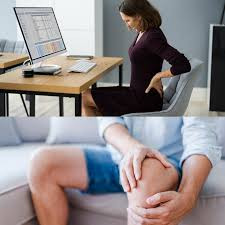“Orthopaedic Warning: How Desk Jobs Harden Joints — What Causes It and How to Stop the Drift”

IIE DIGITAL DESK : Sitting all day may feel harmless, but orthopaedic specialists warn it quietly injures joints and raises the risk of chronic pain. Dr Ashish Mittal of Max Hospital, Dehradun, tells Hindustan Times that long stretches of desk work promote muscle imbalances, joint stiffness and progressive discomfort in the neck, shoulders, spine, hips, knees and wrists — problems that start small but can become persistent if ignored.
The physiology behind this is simple and cumulative. Prolonged immobility reduces circulation and the distribution of synovial fluid that normally lubricates joints; poor posture — slouching, craning the neck or crossing legs — magnifies mechanical stress on discs, facet joints and soft tissues, accelerating stiffness and degenerative change. Medical authorities also link extended sitting to broader metabolic and musculoskeletal risks, which is why clinicians encourage breaking up long seated periods.
Clinically, desk workers commonly present with persistent neck-shoulder tightness, lower-back pain from sustained lumbar flexion, hip-flexor shortening that reduces mobility, knee strain from incorrect sitting angles, and repetitive-use discomfort in the wrists from prolonged typing and mouse use. Over time, a weak core and shortened hamstrings further destabilize joints, making everyday movement less efficient and more painful.
Prevention is straightforward in principle though it requires consistent habits. Experts advise frequent micro-breaks and simple stretching routines to restore blood flow and mobility, ergonomic optimisation of chairs/monitors/keyboards to preserve neutral spine alignment, and incorporation of low-impact aerobic and strength exercises to rebuild core and gluteal support. Evidence shows ergonomic interventions and sit–stand strategies reduce musculoskeletal complaints and improve function, so workplaces that invest in correct chair height, monitor placement and periodic position change see measurable benefits.
For many people these measures will prevent progression; for those whose joints have already deteriorated, orthopaedic solutions range from targeted physiotherapy and pain-management to joint replacement. Modern joint-replacement techniques — including robotic arm-assisted procedures — aim to increase precision, reduce tissue trauma and speed early recovery, with studies reporting less immediate post-operative pain and quicker functional gains compared with traditional techniques, though long-term outcomes and cost factors continue to be studied.
What should an office worker do tomorrow morning? Stand once every 30–60 minutes, perform a short set of neck/hip/hamstring stretches, check that the top of the monitor sits at eye level and that your feet rest flat with hips and knees at roughly 90 degrees. If you already have persistent joint pain, seek early assessment from an orthopaedist or physiotherapist — early intervention prevents years of disability and may avoid the need for surgery. Public health guidance also underscores the wider harms of prolonged sitting, so framing movement as part of the workday — not an optional extra — is both a personal and organisational priority.
Desk work does not have to equal damaged joints. Small, regular changes in posture, workstation setup and brief movement breaks are high-value, low-effort ways to protect mobility and reduce the chance that a stiff neck or sore knee becomes a lifelong problem.
You might also like!














